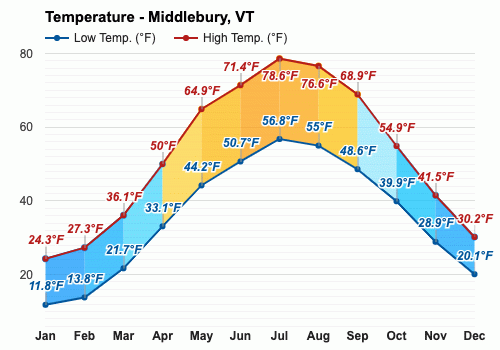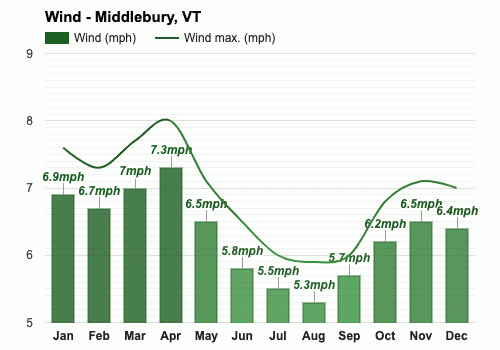Contents
- The climate of Middlebury
- The best time to visit Middlebury
- The worst time to visit Middlebury
- Spring weather in Middlebury
- Summer weather in Middlebury
- Autumn weather in Middlebury
- Winter weather in Middlebury
- Weather in January
- Weather in February
- Weather in March
- Weather in April
- Weather in May
- Weather in June
- Weather in July
- Weather in August
- Weather in September
- Weather in October
- Weather in November
- Weather in December
- Frequently asked questions
- Average temperature
- Average pressure
- Average wind speed
- Average humidity
- Average rainfall
- Average rainfall days
- Average snowfall
- Average snowfall days
- Average daylight
- Average sunshine
- Average sunshine days
- Average UV index
- Average cloud cover
- Average visibility
Climate and monthly weather forecast
The climate of Middlebury
Observing the temperature trends, the warmest months fall between July and August with an average high of around 78.6°F (25.9°C) and 76.6°F (24.8°C) respectively. January and February are the coldest months where temperatures plummet, diving into low average temperatures of about 11.8°F (-11.2°C) to 13.8°F (-10.1°C). In line with temperature trends, the days are the longest from June to July, with the daylight extending to 15.4 hours and 15.1 hours on average. Inferring from the combination of climate figures, a blend of warmth and daylight typifies this period. Middlebury's winter, conversely, coincides with the shortest days where daylight drops to an average of 9 hours approximately in both December and January.
The area's precipitation profile is fairly consistent, split between rainfall and snowfall. Middlebury sees the most rainfall in June at 3.15" (80mm) whilst April and May have rainfall levels close to 2.7" (69mm). In contrast, the town experiences the least amount of rainfall in September at 1.77" (45mm). One could expect nearly 17 days of rainfall from April to July. The town also exhibits a significant shift towards snowfall in colder months, with the greatest amount of snow coming down in January and February at around 9.69" (246mm) and 11.26" (286mm) respectively.
The best time to visit Middlebury
The worst time to visit Middlebury
Spring weather in Middlebury
Summer weather in Middlebury
Autumn weather in Middlebury
Winter weather in Middlebury
Weather in January
Weather in February
Weather in March
Weather in April
Weather in May
Weather in June
Weather in July
Weather in August
Weather in September
Weather in October
Weather in November
Weather in December
Published by: Weather U.S. | About Us
Data Sources | Weather Forecasting & Climate
Frequently asked questions
What month is the coldest in Middlebury?
What are the most humid months in Middlebury?
How many days does it rain in Middlebury?
When does it snow in Middlebury?
How much does it snow in Middlebury?
What are the months with the lowest UV index in Middlebury?
When does it snow the most in Middlebury?
What is the month with the least sunshine in Middlebury?
When is Daylight Saving Time (DST) in Middlebury?
What are the least humid months in Middlebury?
What is the month with the highest UV index in Middlebury?
What is the rainiest month in Middlebury?
When it does not snow in Middlebury?
When are the longest days in Middlebury?
What is the hottest time of year in Middlebury?
What month has the most sunshine in Middlebury?
What is the driest month in Middlebury?
What is the month with the shortest days in Middlebury?

Average temperature
Middlebury, VT
The warmest month (with the highest average high temperature) is July (78.6°F).
The month with the lowest average high temperature is January (24.3°F).
The month with the highest average low temperature is July (56.8°F).
The coldest month (with the lowest average low temperature) is January (11.8°F).

Average pressure
Middlebury, VT
- Average pressure in January:
30.02"Hg - Average pressure in February:
30.01"Hg - Average pressure in March:
30.05"Hg - Average pressure in April:
29.96"Hg - Average pressure in May:
29.98"Hg - Average pressure in June:
29.91"Hg
- Average pressure in July:
29.93"Hg - Average pressure in August:
29.96"Hg - Average pressure in September:
30.05"Hg - Average pressure in October:
30"Hg - Average pressure in November:
30.07"Hg - Average pressure in December:
30.05"Hg
The month with the highest atmospheric pressure is November (30.07"Hg).
The month with the lowest atmospheric pressure is June (29.91"Hg).

Average wind speed
Middlebury, VT
- Average wind speed in January:
6.9mph - Average wind speed in February:
6.7mph - Average wind speed in March:
7mph - Average wind speed in April:
7.3mph - Average wind speed in May:
6.5mph - Average wind speed in June:
5.8mph
- Average wind speed in July:
5.5mph - Average wind speed in August:
5.3mph - Average wind speed in September:
5.7mph - Average wind speed in October:
6.2mph - Average wind speed in November:
6.5mph - Average wind speed in December:
6.4mph
The windiest month (with the highest average wind speed) is April (7.3mph).
The calmest month (with the lowest average wind speed) is August (5.3mph).

Average humidity
Middlebury, VT
The months with the highest relative humidity are January and February (87%).
The months with the lowest relative humidity are April and May (76%).

Average rainfall
Middlebury, VT
- Average rainfall in January:
2.05" - Average rainfall in February:
2.13" - Average rainfall in March:
2.24" - Average rainfall in April:
2.68" - Average rainfall in May:
2.72" - Average rainfall in June:
3.15"
- Average rainfall in July:
2.56" - Average rainfall in August:
2.64" - Average rainfall in September:
1.77" - Average rainfall in October:
2.87" - Average rainfall in November:
2.24" - Average rainfall in December:
2.4"
The wettest month (with the highest rainfall) is June (3.15").
The driest month (with the least rainfall) is September (1.77").

Average rainfall days
Middlebury, VT
- Average rainfall days in January:
8.5 days - Average rainfall days in February:
8.9 days - Average rainfall days in March:
13 days - Average rainfall days in April:
17 days - Average rainfall days in May:
17.2 days - Average rainfall days in June:
17.8 days
- Average rainfall days in July:
17.9 days - Average rainfall days in August:
17.1 days - Average rainfall days in September:
10.9 days - Average rainfall days in October:
16.2 days - Average rainfall days in November:
12.5 days - Average rainfall days in December:
11.4 days
The month with the highest number of rainy days is July (17.9 days).
The month with the least rainy days is January (8.5 days).

Average snowfall
Middlebury, VT
- Average snowfall in January:
9.69" - Average snowfall in February:
11.26" - Average snowfall in March:
7.44" - Average snowfall in April:
2.99" - Average snowfall in May:
0.47" - Average snowfall in June:
0"
The month with the highest snowfall is February (11.26").
The months with the least snowfall are June, July, August and September (0").

Average snowfall days
Middlebury, VT
- Average snowfall days in January:
19.6 days - Average snowfall days in February:
18.6 days - Average snowfall days in March:
14.9 days - Average snowfall days in April:
5.3 days - Average snowfall days in May:
0.5 days - Average snowfall days in June:
0 days
- Average snowfall days in July:
0 days - Average snowfall days in August:
0 days - Average snowfall days in September:
0 days - Average snowfall days in October:
1.2 days - Average snowfall days in November:
7.2 days - Average snowfall days in December:
14.7 days
The month with the highest number of snowfall days is January (19.6 days).
The months with the least snowfall days are June, July, August and September (0 days).

Average daylight / Average sunshine
Middlebury, VT
- Average daylight in January:
9h and 2min - Average daylight in February:
10h and 3min - Average daylight in March:
12h and 0min - Average daylight in April:
13h and 3min - Average daylight in May:
14h and 5min - Average daylight in June:
15h and 2min
- Average daylight in July:
15h and 1min - Average daylight in August:
14h and 0min - Average daylight in September:
12h and 3min - Average daylight in October:
11h and 0min - Average daylight in November:
9h and 4min - Average daylight in December:
9h and 0min
The month with the longest days is June (Average daylight: 15h and 24min).
The month with the shortest days is December (Average daylight: 9h and 0min).
- Average sunshine in January:
3h and 2min - Average sunshine in February:
3h and 1min - Average sunshine in March:
4h and 4min - Average sunshine in April:
7h and 0min - Average sunshine in May:
8h and 1min - Average sunshine in June:
8h and 4min
- Average sunshine in July:
10h and 1min - Average sunshine in August:
9h and 5min - Average sunshine in September:
8h and 2min - Average sunshine in October:
4h and 5min - Average sunshine in November:
4h and 5min - Average sunshine in December:
3h and 4min
The month with the most sunshine is July (Average sunshine: 10h and 6min).
The month with the least sunshine is February (Average sunshine: 3h and 6min).

Average sunshine days
Middlebury, VT
- Average sunshine days in January:
8.9 days - Average sunshine days in February:
7.5 days - Average sunshine days in March:
8.8 days - Average sunshine days in April:
9.6 days - Average sunshine days in May:
11.6 days - Average sunshine days in June:
10.8 days
- Average sunshine days in July:
10 days - Average sunshine days in August:
11.8 days - Average sunshine days in September:
16.4 days - Average sunshine days in October:
12 days - Average sunshine days in November:
13.5 days - Average sunshine days in December:
10.4 days
The month with the most sunshine days is September (16.4 days).
The month with the least sunshine days is February (7.5 days).

Average UV index
Middlebury, VT
The months with the highest UV index are May, June, July and August (UV index 5).
The months with the lowest UV index are January, February and December (UV index 1).

Average cloud cover
Middlebury, VT
The month with the most cloud cover is February (Cloud cover 68).
The months with the least cloud cover are July and August (Cloud cover 37).

Average visibility
Middlebury, VT
The months with the highest visibility are April, May, June, July, August, September, October, November and December (5mi).
The months with the lowest visibility are January, February and March (4mi).